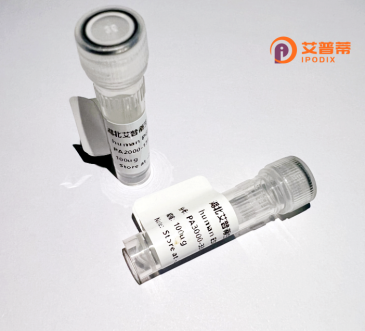
| 纯度 | >90%SDS-PAGE. |
| 种属 | Human |
| 靶点 | FBXO33 |
| Uniprot No | Q7Z6M2 |
| 内毒素 | < 0.01EU/μg |
| 表达宿主 | E.coli |
| 表达区间 | 1-555aa |
| 氨基酸序列 | MLLFLSVPQPRPPGARTRAGAARVARWRRLRLQQLRRLRGLLRVLRGRPGAGSRRRGRMALCGQAAGAASLPSELIVHIFSFLPAPDRLRASASCSHWRECLFYPALWPQLRICLRVSPAEQPRLEFLMRKCGWFVRELRVEFAAENYLSGGGPGDGGGADTGTGGEEVEALQLSARWLEVLRTYLELVLCVLVSIRNNRNLQKFSLFGDISVLQQQGSLSNTYLSKVDPDGKKIKQIQQLFEEILSNSRQLKWLSCGFMLEIVTPTSLSSLSNAVANTMEHLSLLDNNIPGNSTLITAVELERFVNLHSLALDFCDFTAEMARVLTDSNHVPLQRLSLLVHNVSVMHKSLDNMPNDEHWKALSRKSTSFRVYIMAFDIKSEDMLKILKPSIPLERIHFDSYITCVSGAIVDLISRQYDKFLTHFILMNDVIDTSGFPDLSDNRNEDPLVLLAWRCTKLSLLAIHGYTVWAHNLIAIARLRGSDLKVLEVTEESIDFDQGELADQDVDPVHNLIEQVSLGLGQPWHAVMDIESLSVFTEPNRHFYREMQSFSEDI |
| 分子量 | 89 kDa |
| 蛋白标签 | GST-tag at N-terminal |
| 缓冲液 | 0 |
| 稳定性 & 储存条件 | Lyophilized protein should be stored at ≤ -20°C, stable for one year after receipt. Reconstituted protein solution can be stored at 2-8°C for 2-7 days. Aliquots of reconstituted samples are stable at ≤ -20°C for 3 months. |
| 复溶 | Always centrifuge tubes before opening.Do not mix by vortex or pipetting. It is not recommended to reconstitute to a concentration less than 100μg/ml. Dissolve the lyophilized protein in distilled water. Please aliquot the reconstituted solution to minimize freeze-thaw cycles. |
1. **"FBXO33 mediates the proteasomal degradation of MYC and promotes neuronal differentiation" by Smith et al.**
该研究阐明重组人FBXO33蛋白通过SCF泛素连接酶复合物介导致癌转录因子MYC的泛素化与降解,进而调控神经细胞分化,体外实验显示FBXO33特异性识别磷酸化形式的MYC。
2. **"Structural insights into the F-box protein FBXO33 substrate recognition" by Chen et al.**
作者利用重组表达的人FBXO33蛋白进行X射线晶体学分析,揭示其F-box结构域与Skp1的结合模式,并发现其C端结构域通过线性基序识别底物,为泛素化机制提供结构基础。
3. **"FBXO33 regulates pulmonary fibrosis via ubiquitination of SMAD3" by Li et al.**
研究发现重组人FBXO33蛋白在肺纤维化中负向调控TGF-β信号通路,通过泛素化降解磷酸化SMAD3蛋白,抑制成纤维细胞活化,提示其作为潜在治疗靶点。
4. **"The F-box protein FBXO33 interacts with RNA-binding proteins and influences stress granule dynamics" by Wang et al.**
该文献报道重组FBXO33蛋白与多聚嘧啶区结合蛋白(PCBP)等RNA结合蛋白相互作用,在细胞应激条件下调控应激颗粒的形成,暗示其在RNA代谢和细胞应激反应中的新功能。
The recombinant human FBXO33 protein is a key component of the SCF (SKP1-CUL1-F-box) ubiquitin ligase complex, which plays a critical role in protein ubiquitination and subsequent degradation via the proteasome. FBXO33. an F-box protein, contains a conserved F-box domain that mediates interactions with SKP1. bridging substrate recognition subunits to the core ligase machinery. Functionally, FBXO33 is implicated in regulating diverse cellular processes, including cell cycle progression, DNA damage response, and apoptosis. Studies suggest it targets specific substrates, such as transcriptional regulators or chromatin-associated proteins, for proteasomal degradation, thereby influencing gene expression and genome stability. Dysregulation of FBXO33 has been linked to pathologies like cancer, neurodegenerative disorders, and immune dysfunction. Recombinant FBXO33 is typically produced in heterologous systems (e.g., *E. coli* or mammalian cells) for in vitro studies, enabling exploration of its enzymatic activity, substrate interactions, and structural properties. Current research focuses on clarifying its substrate spectrum, regulatory mechanisms, and therapeutic potential. Despite progress, the precise physiological roles of FBXO33 and its context-dependent functions in disease remain partially unresolved, necessitating further biochemical and functional analyses. This protein's study may unlock insights into ubiquitination pathways and novel drug targets.
×